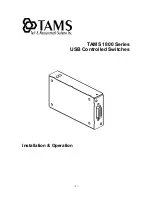
Doc#
M9005 • REV N
(May 2017) Page
9 of 12
Figure 7:
Auto reset
CAUTION:
This test should be performed with the machin
-
ery not running or switch outputs by-passed. After testing,
reset the limits to the proper operational values.
CAUTION:
Disconnect or disarm the machine alarms and/or
shutdown circuits prior to testing the vibration switch outputs.
TROUBLESHOOTING
1. The unit appears to be functioning, but limit operation is in question.
a) Operation of the limit triac/FET and the attached relay can be verified by toggling the NO/
NC switch.
b) The limit setting can be rotated to the minimum (-10%) setting in order to exercise all of
the limit control logic and trip delay circuits. The limit triac/FET should operate and the limit
LED should turn on after the set trip delay expires. REMEMBER to return the limit setting to
the original position after this test.
c) If the LED is lit but the limit is not functioning, check to make sure the triac/FET load is
wired properly and power is present at the limit terminal block and relay. CAUTION: voltages
at the limit switch terminal block can be dangerous. Exercise caution when checking for volt
-
age at the terminal block. For AC loads, ensure the minimum current through the load is 35
mA for temperatures above 25°C or 60 mA below 25°C. For DC loads, ensure proper wiring
polarity has been observed.
2. The unit appears to be functioning, but the 4-20 mA operation is in question.
a) Ensure that the current loop is wired properly and that the total loop resistance does not
exceed 600 ohms. The Model SW6000 4-20 mA circuit is a current source. A voltage source
(power supply) must not be used in the circuit.






























